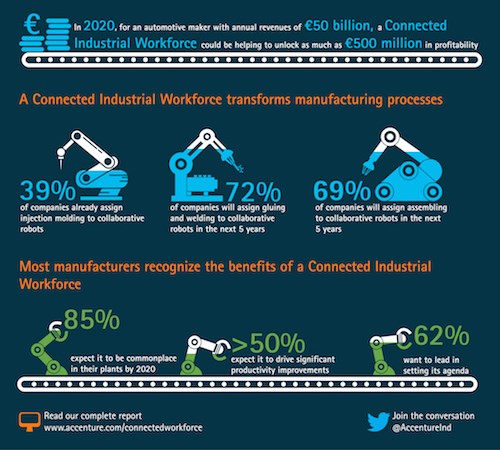Connected: The Factory of the Future Is Closer Than We Think
“Enabling humans to collaborate with machines, in a real-time, two-way exchange.”
“Enabling humans to collaborate with machines, in a real-time, two-way exchange.”
That would be the result of implementing a “Connected Industrial Workforce”, according to a new study released by Accenture Consulting. Despite a somewhat whimsical title—Machine Dreams: Making the Most of the Connected Industrial Workforce—the report points to some very down-to-earth benefits to such worker/machine connectivity, including significant gains to productivity, improved operational efficiency and enhanced safety and risk management.
Taking a step back, what exactly does a Connected Industrial Workforce look like? According to Accenture, in a factory this would include technologies like collaborative robots (or cobots, an issue we tackled here), augmented reality devices (“smart” glasses and helmets relaying data to workers and sending it back to a central hub), smarter machines (think equipment that talks to workers and other machines), and the souped-up IT infrastructure needed to run all this.
Smart glasses on the shopfloor might be some ways off (but not for Lockheed, according to Popular Mechanics), but one area that has already seen adoption would be autonomous guided vehicles, or mobile robots that move materials and products around a warehouse. According a survey of 500 executives in the U.S., Europe, and Asia conducted by Accenture, such vehicles already account for half of Connected Industrial spending by companies today with an even greater share anticipated in the future. Fully 39% of companies in the survey already assign injection molding machine output to collaborative robots.
The survey also found that the same organizations plan to increase investments in cobots and the aforementioned augmented reality devices, over the next five years. Where’s all this headed? According to 85% of respondents:
They expect the focus of technology in manufacturing to evolve from human to human-machine-centric, where collaborative machines, humans augmenting machines and autonomous machines are combined to create a more effective workforce.
Fully 85% of those polled expect the concept of a Connected Industrial Workforce to be commonplace in plants by 2020, but that’s not to say some challenges aren’t anticipated, with 85% describing their companies as digital followers. What’s the hold up? Security concerns and the shallow skills pool, with 76% worried about data vulnerability, 72% concerned over system vulnerability and 70% fretting about a shortage of skilled workers.
That’s not to say the field will not continue to progress, despites these and other challenges. Respondents estimated up to 25% of their R&D expenditure over the next five years would go toward connected industrial workforce technologies, at a value of €181 billion ($205 billion) for automotive companies and €39 billion ($44 billion) for industrial equipment companies.
Back to those “machine dreams”; the classic sci-fi movie Blade Runner, which turns 35 next year and features some “cobots” that are not in a very collaborative mood, was based off Philip K. Dick’s 1968 novel, “Do Androids Dream of Electric Sheep?”. Nearly 50 years after its publication, maybe we’ll find out what cobots or fully connected processing machines dream about when their shift has ended in the near future.

Read Next
Advanced Recycling: Beyond Pyrolysis
Consumer-product brand owners increasingly see advanced chemical recycling as a necessary complement to mechanical recycling if they are to meet ambitious goals for a circular economy in the next decade. Dozens of technology providers are developing new technologies to overcome the limitations of existing pyrolysis methods and to commercialize various alternative approaches to chemical recycling of plastics.
Read MorePeople 4.0 – How to Get Buy-In from Your Staff for Industry 4.0 Systems
Implementing a production monitoring system as the foundation of a ‘smart factory’ is about integrating people with new technology as much as it is about integrating machines and computers. Here are tips from a company that has gone through the process.
Read MoreTroubleshooting Screw and Barrel Wear in Extrusion
Extruder screws and barrels will wear over time. If you are seeing a reduction in specific rate and higher discharge temperatures, wear is the likely culprit.
Read More






















